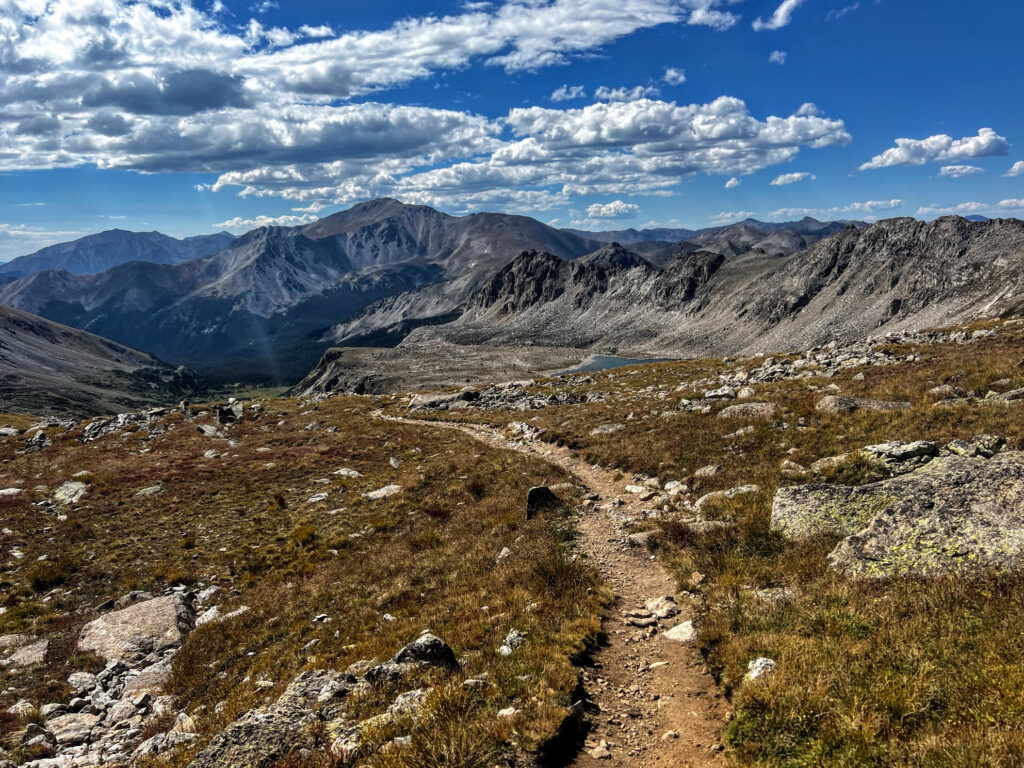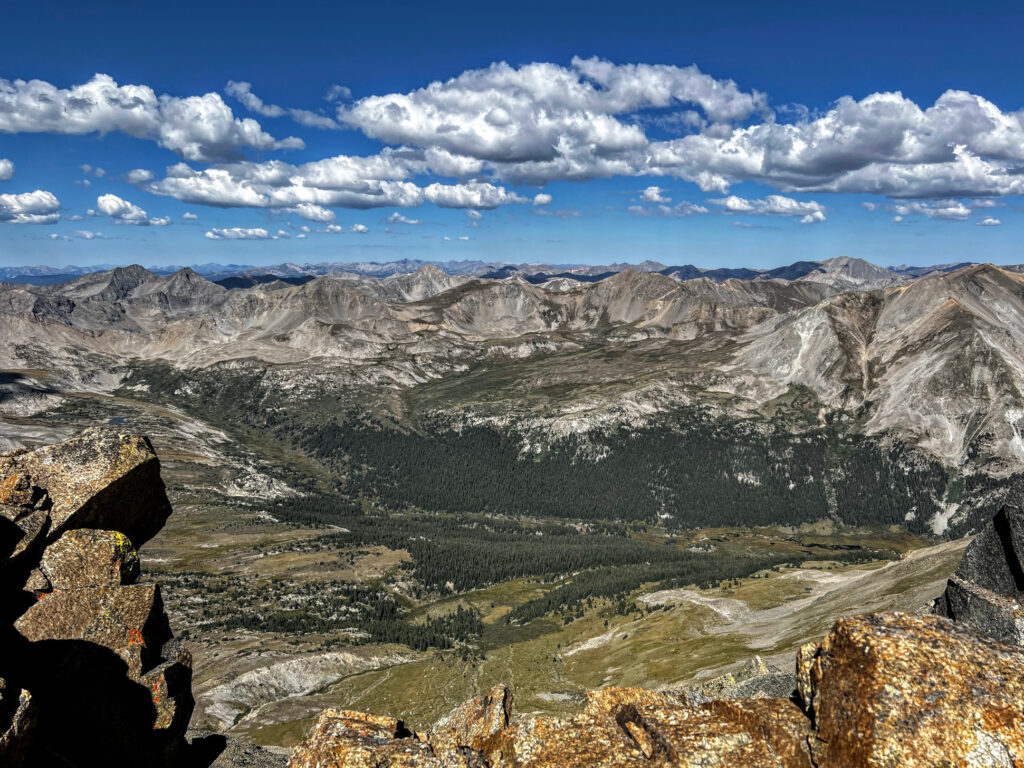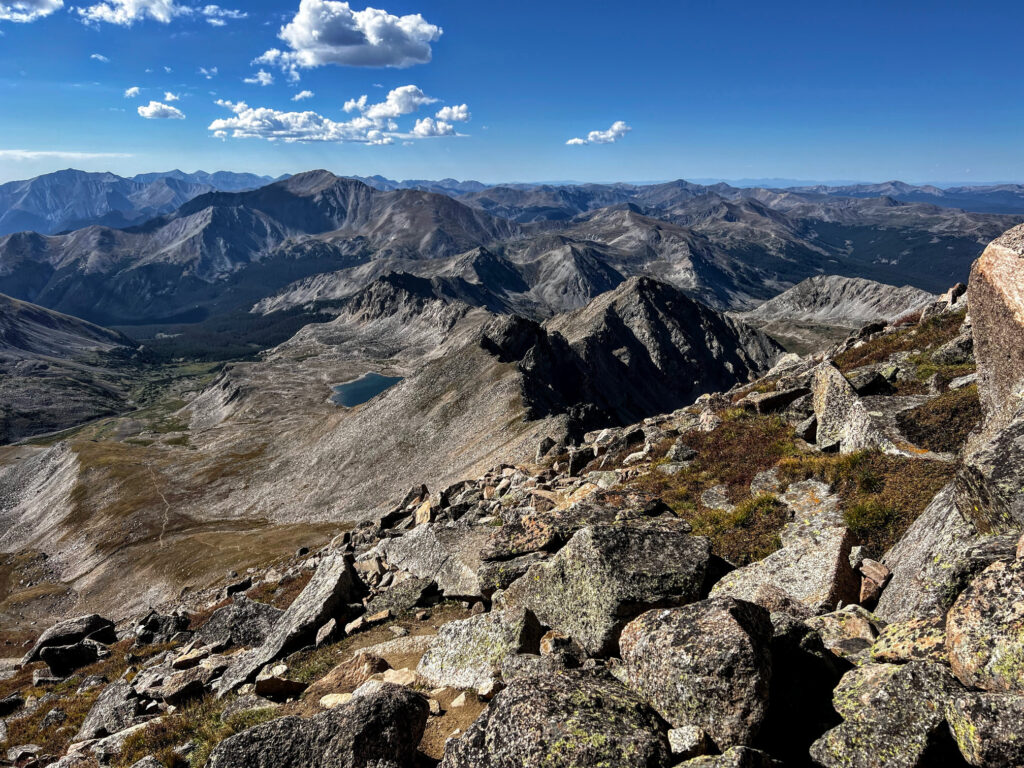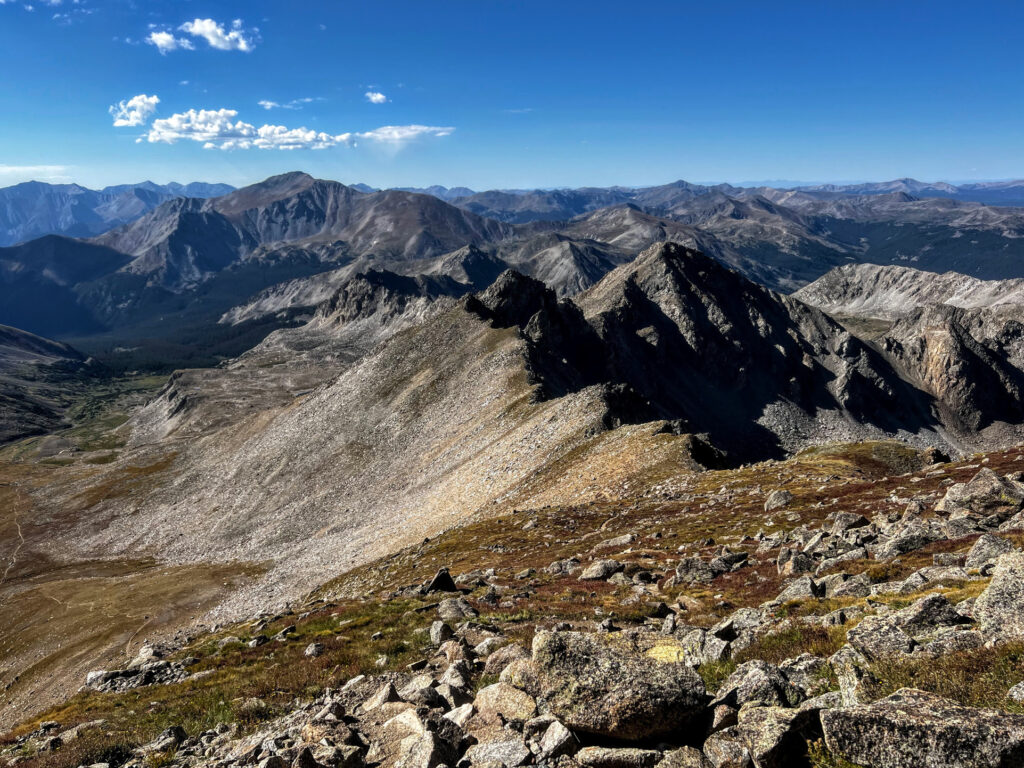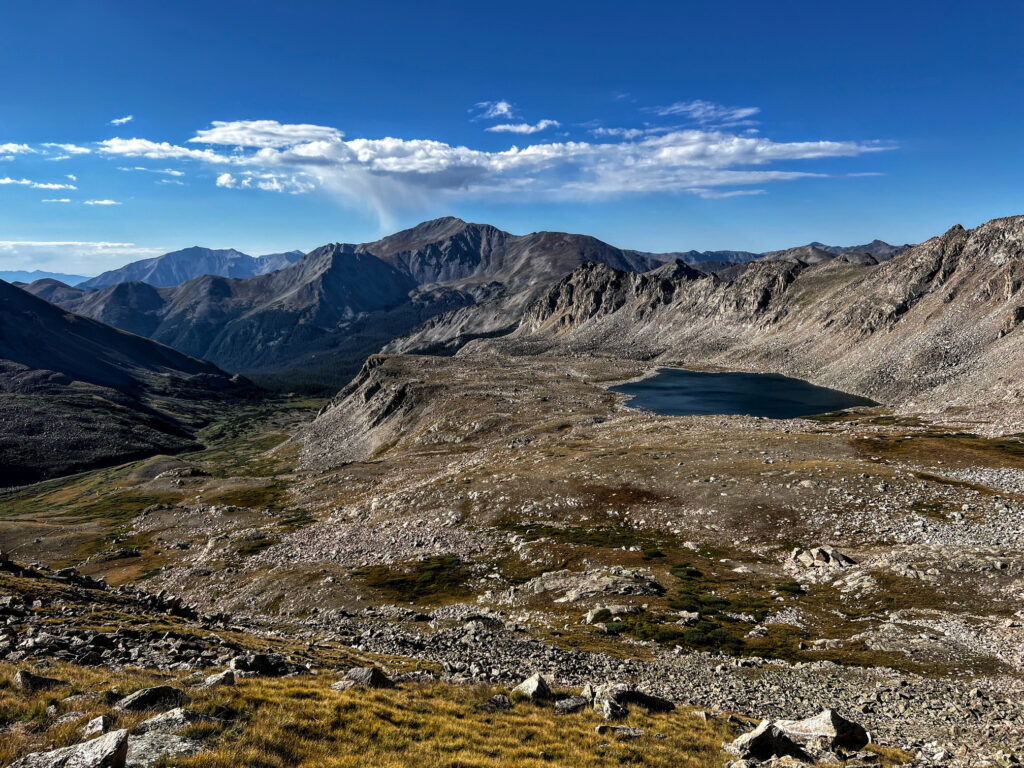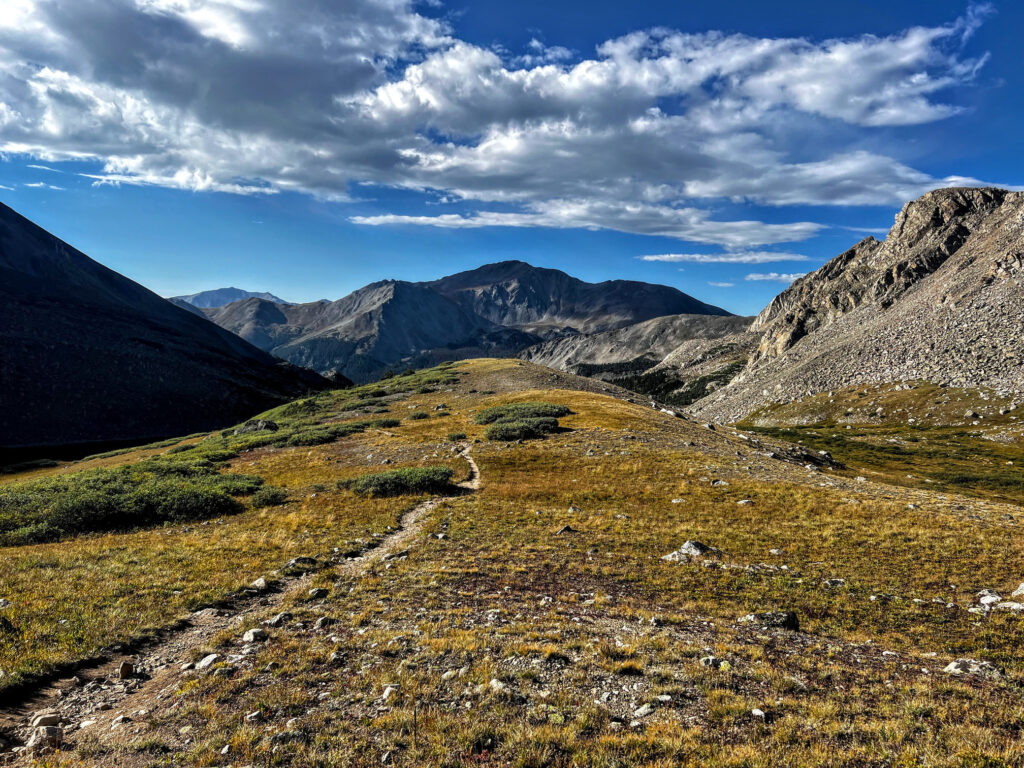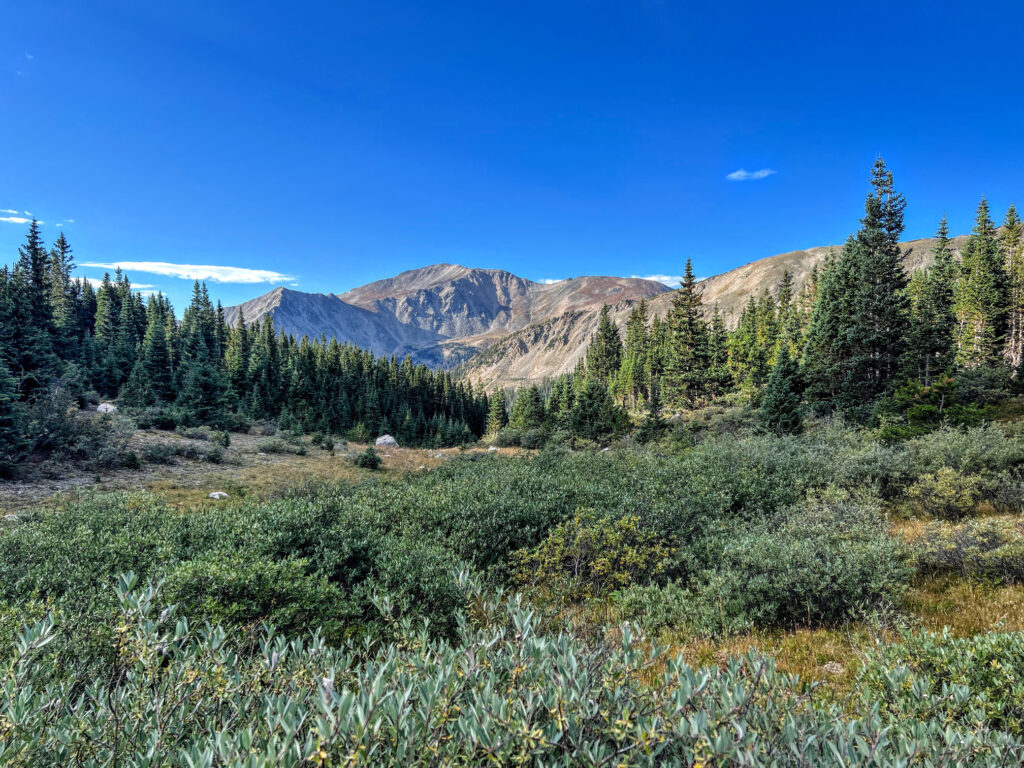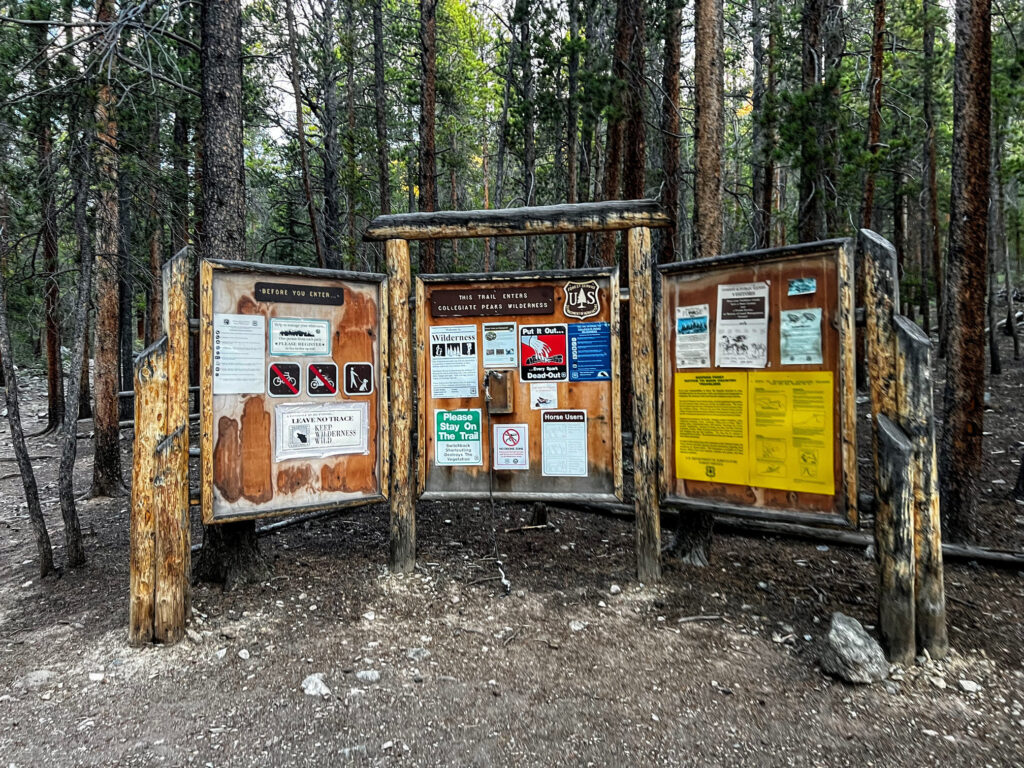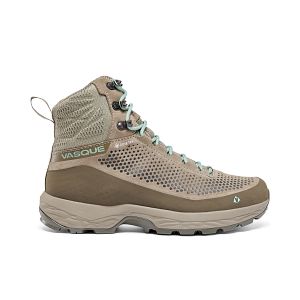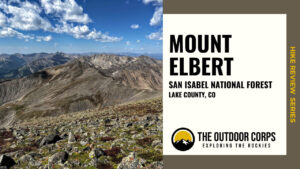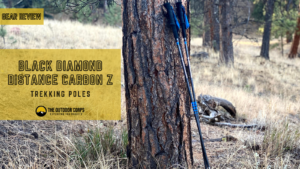Mount Harvard (14,420ft.) is a 14er mountain located in Colorado’s Sawatch Range, within the Collegiate Peaks Wilderness and the greater San Isabel National Forest. As the third tallest mountain in Colorado and the fourth tallest mountain in the contiguous U.S., Mount Harvard is only slightly smaller than Mount Elbert (14,440ft.) and Mount Massive (14,421ft.), the two highest peaks in the state.
The standard Mount Harvard route via its South Slopes is easily accessed at the North Cottonwood Creek Trailhead. As with many Sawatch Range mountain ascents, the South Slopes route to the summit of Mount Harvard is long and steep at 14.1 miles roundtrip with 4,527ft. of elevation gain. Indeed, the South Slopes route is rated Class 2, with some fairy significant boulder scrambling and exposure at the route’s summit crux. We consider this route a substantial challenge for a day hike, but achievable with proper preparation and training.
HIKE REVIEW SERIES: Mount Harvard
Mountain Information
In 1869, members of the Harvard University School of Mining and Practical Geology embarked on an expedition with geologist Josiah Whitney and named Mount Harvard in honor of Harvard University. Whitney was notably the chief of the California Geological Survey and a founding faculty member of the Harvard school of mines. However, Whitney was a Yale University alum, hence nearby Mount Yale obtained its namesake in honor of Whitney’s alma mater.
Staying with the trend of naming peaks after prestigious universities, Mount Harvard and Mount Yale neighbor other 14er peaks such as Mount Columbia and Mount Oxford within the magnificent Collegiate Peaks Wilderness and the larger Sawatch Range. Congress designated the Collegiate Peaks Wilderness area in 1980, which encompasses approximately 168,000 acres and is home to some of Colorado’s most breathtaking mountains.
As with nearly every Colorado 14er mountain, Mount Harvard is extremely popular especially because of its status as the third tallest peak in Colorado. In addition, Mount Harvard is directly adjacent to Mount Columbia (14,073ft.) which offers a compelling opportunity to reach two 14er summits. Thus, due to this popularity, plan to hike on a weekday or arrive early in the morning for less trail traffic.
Mount Harvard
- Summit Elevation: 14,420ft.
- Range: Sawatch
- Sub-range: Collegiate Peaks
- Location: San Isabel National Forest
- Nearest Town: Buena Vista
Trail Guide
Route Information
- Route: South Slopes
- Class: 2
- Type: Out-and-Back
- Trailhead: North Cottonwood Creek
- Trailhead Elevation: 9,929ft.
- Route Length: 14.1 miles
- Elevation Gain: 4,527ft.
Route Overview
The Class 2 South Slopes route to Mount Harvard begins at about 9,900ft. at the North Cottonwood Creek Trailhead on the Horn Fork Basin Trail. In about 500ft., cross a footbridge over North Cottonwood Creek and begin a gradual ascent through the forest entering into the Collegiate Peaks Wilderness. The ascent continues to another bridge crossing at about 1.5 miles into the trek. Here the trail starts to steepen and reaches a junction with a trail leading to Kroenke Lake/Brown’s Pass to the left; stay right on the Horn Fork Basin Trail to continue ascending.
At about 3.5 miles into the climb, reach another junction sign noting Mount Harvard/Bear Lake straight and Mount Columbia to the right. Keep straight on the Horn Fork Basin Trail heading into the Horn Fork Basin. Beautiful views of Mount Yale will be behind, with Mount Harvard straight ahead and Mount Columbia to the east. The trail begins to enter willows and leads to a crossing of Horn Fork Creek.
At approximately 12,300ft., reach the trail junction with Bear Lake to the left. Head straight here on the Mount Harvard South Slopes trail and eventually begin to enter trail comprised of talus and small boulders. The trail exits the talus for a bit into tundra with navigation aided by large cairns and starts to steepen again into rockier terrain ascending the southern slope of Mount Harvard. Reach the crux just below Mount Harvard’s summit where the trail seems to abruptly stop. Choose the clearest path to scramble through the boulders to reach the summit.
Atop Mount Harvard, notice the connection to Mount Columbia and enjoy the views below into the Horn Fork Basin and beyond. Descend by doubling back, carefully down-climbing from the summit and retracing steps back to the North Cottonwood Creek Trailhead.
Planning Tips
Getting There
From Buena Vista, CO, continue on US 24 through town then turn onto Crossman Ave.. Stay straight on this road for about two miles, as it eventually turns into County Road 350. Turn right onto County Road 361 and in about one mile, take a sharp turn onto the dirt County Road 365, which transitions into Forest Road 365 as it enters the National Forest. Pass by the Silver Creek Trailhead on the left and numerous dispersed campsites along the way to eventually reach the North Cottonwood Creek Trailhead parking area.
Note that County Road 365/Forest Road 365 is accessible with most vehicles. However, the road is rutted in certain sections; therefore, 4WD high clearance vehicles will have an easier time navigating the bumpy dirt road.
Parking
The standard South Slopes route to Mount Harvard begins at the North Cottonwood Creek Trailhead parking area, which is also the starting point for Mount Columbia’s standard route. Though there are ample parking spaces that can accommodate approximately 30 vehicles, expect this lot to be busy. Further, this lot is unpaved with plenty of rocks and trees to navigate around. Primitive restrooms are available at the trailhead.
Camping
There are a number of dispersed campsite options to choose from along the road (Forest Road 365) toward the North Cottonwood Creek Trailhead. If a more established campground is preferred, the Collegiate Peaks Campground is a large reservable campground that is approximately 30 minutes from the trailhead. Alternatively, Cottonwood Lake Campground is about 40 minutes from the North Cottonwood Creek Trailhead and sites are available on a first-come, first-served basis.
Pets
Dogs are permitted on leash. Note, there is some fairly significant boulder scrambling and moderate exposure at the crux of this route to Mount Harvard’s summit. Accordingly, if you do opt to bring your pet, please be considerate of others by keeping your pet on leash and picking up/packing out any dog waste.
Weather Forecast
Always check the weather forecast before venturing into alpine country. Thunderstorms and lightning are frequent occurrences in Colorado during the summer time, so plan ahead for your Mount Harvard 14er summit adventure.
RECOMMENDED HIKING APPAREL AND GEAR
Ten Essentials
When hiking in Colorado, you should always be prepared for sudden changes in weather, especially on 14er hikes. Therefore, you should carry the appropriate type and amount of gear, clothing, food, water, and other essentials. For certain, make sure that your packing list includes the Ten Essentials. It’s best to always be prepared!
Hiking Boots
The Vasque Torre hiking boots are incredibly lightweight, provide excellent traction, and are quite affordable for their versatility. We like the Vasque Torre’s for everyday hiking that includes a bit of scrambling. In addition, with the “GORE-TEX” construction, you don’t have to worry about damp feet if the weather turns or you have to splash through streams or puddles along the way.
Hiking Pants
We love prAna’s hiking pants for their quality and versatility. Indeed, their Zion (for men) and Halle (for women) are great on- and off-trail, especially for travel. Constructed with a durable UPF-50 fabric, a water-repellant finish, and utility pockets, these have become a staple in our wardrobe. Remember that it can be rather chilly at alpine elevations, so consider hiking pants rather than shorts (both for warmth and sun protection).
Hiking Shirt
It can get chilly during alpine outings, particularly when you start early in the morning. Therefore, we typically opt for a long sleeve but lightweight shirt to keep us warm when it’s cold, but keeps us cool when we are working up a sweat later in the day. The no-cotton rule applies to shirts just as it does for pants and other articles of clothing.
Our preferred hiking shirt in the summer is Outdoor Research’s Echo Hoody because of its UPF sun protection qualities and lightweight (4oz.) breathable construction. The shirt has a hood for added neck protection and has thumbholes to protect your hands from sun exposure, if you opt to not wear sun gloves. Outdoor Research also makes different varieties of the Echo shirt (e.g., quarter zip, long sleeve without hood, t-shirt, etc.) if you prefer another style.
Insulated Jacket
The Arc’teryx Atom is easily our favorite insulated jacket. Yes, there may be lighter weight alternatives on the market, but we love the style, fit, packability, and function. Wear the Atom during early morning starts or when you reach the mountain summit. It’s a great addition to an outdoors wardrobe and comes in handy when the temperature dips.
Hiking Socks
For most of our hiking needs, we like Darn Tough socks over the multitude of options on the market. They last long and have an ironclad guarantee. In addition, Darn Tough has a variety of designs, ankle lengths, and cushioning options to choose from. We like the Hiker quarter length with light cushioning.
Headwear/Face Covering
We often wear a Buff as a neck gaiter to protect from the sun, given its UPF 50 protective construction. Buffs are also a great option to use as a face covering on the trail. In fact, there are 12+ ways of wearing a Buff, so it’s a versatile piece of gear.
Day Pack
To summit Mount Harvard, we like REI Co-op’s Flash 22L pack for its affordability, lightweight design, and overall versatility. This pack has enough storage for a day hike and side pockets are available to store Nalgene bottles or other equipment. It is also hydration reservoir compatible. We think the 22L version has the perfect capacity, though REI does have an even smaller Flash 18L with a drawcord top.
Trekking Poles
Although trekking poles are optional and a matter of preference, we prefer to use them for added stability. We recommend choosing the lightest weight poles your budget can afford. The Black Diamond Distance Z is our top choice due to its extremely lightweight construction. If you are seeking just one pole, rather than two, consider Gossamer Gear’s LT5, which can be purchased individually.
recommended books
We recommend bringing along a topographical map of the area, such as the “Outdoor Trail Maps 14er Series: Columbia, Harvard, Belford, Huron, Missouri, and Oxford.” A good topographical map is always nice to have in addition to a GPS device, if you’re using one. In addition, we included a couple of our favorite field guides for plant and bird identification to aid in the enjoyment of your outdoor adventure. Lastly, we included Gerry Roach’s “Colorado’s Fourteeners: From Hikes to Climbs” guidebook, which is the best print guide available for hiking Colorado’s 14ers. It provides an amazing amount of information on Mount Harvard and other 14er hikes in Colorado that may be of interest.
- Colorado’s Fourteeners: From Hikes to Climbs
- A Climbing Guide to Colorado’s Fourteeners
- Colorado 14ers: The Standard Routes
- Outdoor Trail Maps 14er Series: Columbia, Harvard, Belford, Huron, Missouri, and Oxford
- Outdoor Trail Maps Colorado 14ers Series Sawatch Range Map Pack
- Rocky Mountain Wildflowers Field Guide
- Roadside Geology of Colorado
- Mammals of Colorado Field Guide
- American Birding Association Field Guide to the Birds of Colorado
- Sibley Birds West: Field Guide to Birds of Western North America
Disclosure: Please note that this post contains affiliate links. We may receive a small commission if you buy a product or service through an affiliate link. This revenue helps us provide readers with helpful content to plan amazing adventures.




